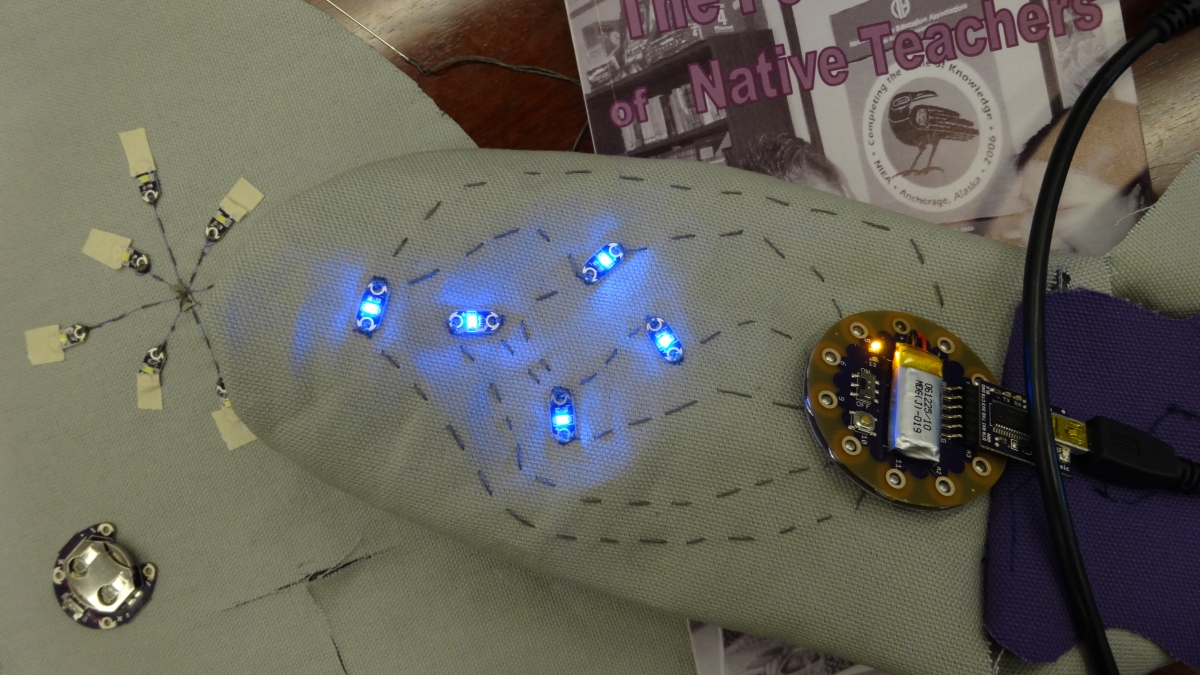ASU technology weaves electronics, indigenous culture

The misconception that technology includes anything with a microchip is prevalent today, but technology goes beyond just mere circuits and wires.
Arizona State University’s E2 (ethno-electronic) Textiles Project combines hundreds of years of indigenous culture and melds it with electronics to create educational, innovative art – a perfect balance that simultaneously honors the past as it steps toward the future.
Featured in ASU’s newest College of Liberal Arts and Sciences Magazine, professor Bryan Brayboy of ASU’s School of Social Transformation explains that e-textiles introduce lights, namely LED lights, in apparel such as boots, jackets and shirts, much like the clothing worn by the band Black Eyed Peas during their 2011 halftime show at the Super Bowl.
“E2-textiles allow us to connect computer science programming and what people already know,” Brayboy said.
An example of “what’s known” is the numerous canal systems seen throughout the valley created by the Hohokam; Brayboy calls this type of native knowledge Indigenous Knowledge Systems (IKS).
“Combining indigenous ways of knowledge with computer programming helps young people understand technology is not just electronics,” Brayboy said.
Brayboy said he hopes the program resonates with students and their culture.
“I want to help young people see the connection between IKS and programming, and get people to understand that technology is also about utilizing the environment around you to survive,” Brayboy said. “Your iPad is not the only form of technology.”
Brayboy credits Kristin Searle, a doctoral candidate from University of Pennsylvania and affiliate faculty with ASU, for bringing the project to ASU.
“I knew we needed a grant partner who could facilitate a strong partnership with a native community and Dr. Brayboy was able to do that through ASU’s Center for Indian Education,” Searle said.
“The idea with e-textiles is not only to make art that is pleasing to look at, but develop that art with technology in the form of computer programming through student creation,” Brayboy said. “Students use a computer to program a microcontroller, a Lilypad Arduino, the size of a quarter. This small computer is sewn into the clothing with conductive thread, and what the student has programmed determines whether the LEDs light up to the beat of music or other things.”
Searle is collaborating with Cristobal Martinez, an ASU graduate student whose abilities have proven invaluable to the project.
“He’s a master artist and an energetic teacher,” Searle said. “His scholarship constantly brings new perspectives to bear on our collective research.”
“Martinez and Searle spend around 40 minutes a day with young people teaching them what it is to be a native person,” Brayboy said. “What does it mean for these students to learn about their culture and native language? You get to do this and still be an O’odham or Piipaash.”
The ability of the program to travel from classroom-to-classroom is key to the program’s success.
“Nothing is more rewarding than when a student seeks out a computer to program an e-textile birthday present for her mother outside of class time or when a teacher reports that a student wore his light-up jacket throughout English class,” Searle said. “Students’ curiosity and the ways in which they have experimented with and pushed back against our curriculum have fundamentally altered how we think about teaching and learning with e-textiles materials.”
Not only does the project provide illuminating, intrinsic value, but it’s potentially a lifesaving tool. Lighted apparel can alert drivers to the presence of children on the street or road, and it is especially useful in places like Alaska, where children walk to school during Alaska’s 24-hour cycle of darkness.
“It’s a big issue in Alaska when it gets dark in the winter,” Brayboy said. “You can do this with reflective tape too, but it’s the process of creating art and design that is compelling.”
As the project grows and continues to evolve, Brayboy is already thinking about what’s next for the project.
“The next iteration for us is how to potentially introduce programming courses out at Salt River Pima-Maricopa Indian Community taught by faculty at ASU,” Brayboy said. “What we’re talking about here is an opportunity for people to be involved with their community and to be computer scientists.
“That is what we should be doing as an institution. Giving students who are invested in the state the power to accomplish their goals,” he said.
Read more about this project, alumni, student and faculty stories: CLAS Magazine.
Story written by Anthony Costello